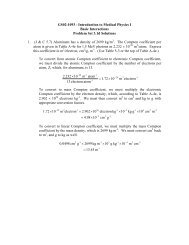link to lecture transcript - UT-H GSBS Medical Physics Class Site
link to lecture transcript - UT-H GSBS Medical Physics Class Site
link to lecture transcript - UT-H GSBS Medical Physics Class Site
Create successful ePaper yourself
Turn your PDF publications into a flip-book with our unique Google optimized e-Paper software.
What about the scatter coefficient? Remember when we have attenuation, two<br />
things can happen. Some of the energy can be transferred <strong>to</strong> charged particles,<br />
while some of the energy can go <strong>to</strong> a scattered pho<strong>to</strong>n. So the scatter coefficient is<br />
going <strong>to</strong> be equal <strong>to</strong> the <strong>to</strong>tal coefficient minus the energy transfer coefficient.<br />
At low energies, the energy transfer is small, so the scatter coefficient is<br />
approximately equal <strong>to</strong> the <strong>to</strong>tal attenuation coefficient. Comp<strong>to</strong>n scatter is not a<br />
good process for transferring energy <strong>to</strong> charged particles at low energies, but this is<br />
also consistent with classical scatter, so we do wind-up getting the coherent scatter<br />
in the limit of low energies.<br />
At high energies, almost all of the energy gets transferred <strong>to</strong> charged particles.<br />
Consequently, q y the scatter coefficient approaches pp zero. So the scatter coefficient<br />
goes between the <strong>to</strong>tal attenuation coefficient at low energies and zero at high<br />
energies.<br />
Now, let’s use this information about coefficients <strong>to</strong> deduce some properties of<br />
energy transfer and energy absorption.<br />
17





